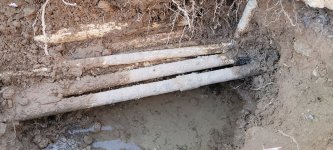Good news and bad news.
The good news, getting close to finding the leak - being dug out as we speak.
I did the initial digging until I actually found some water and mud, now I have a two-man crew digging the area.
Currently not sure which pipe is leaking (there are several all close together), but I was told if it's the main line we have to drain out the entire pool to repair.
It doesn't appear to be a severe leak, as there is not exactly a big pool of water building. The diggers, who are plumbers, for the moment don't think it's some big crack.... they believe more likely to be heavy dripping. Seems to be worse when pump is on.
If the pool has to be drained out to repair, I will likely leave the leak alone for a few weeks - as the entire pool is being drained to get replastered at the end of January. At that point, someone can come back and easily fix the bad pipe since everything will already be dug up. I would do the fix now, but I don't believe it's wise to leave the pool drained for weeks (even longer once they start the replaster job) (open to suggestions if I should do otherwise)
My pool guy said if the pump is making the leak worse, then maybe I should turn the pump off until the replaster job or at the very least not use it on a daily basis or cut the hours down per day. Nobody swims now.
It's so frustrating that a minor leak, 20-25 feet away from the pool and nearly at the equipment, could only be fixed by draining out an entire pool (if the main drain line is the culprit)



